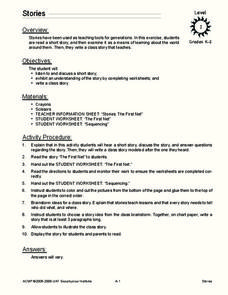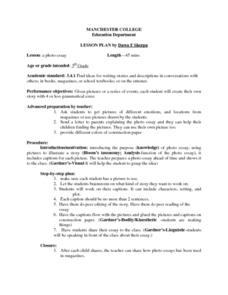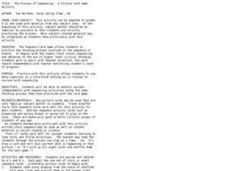Curated OER
The Magic Apple
A fun and delicious lesson can help your kids learn about plural nouns and story sequencing. After reading The Magic Apple by Rob Cleveland, kids match pictures to story segments and add s to nouns to make them plural. They then cook...
Novelinks
Tuck Everlasting: Time-Line Graphic Organizer Strategy
What happens first in Tuck Everlasting? What happens after that? Prompt readers to create a timeline of the events in Natalie Babbitt's novel, detailing both story sequence and character relationships.
Kiwi Crate
Story Cards
Inspire your class to tell some creative stories with a series of story cards. They arrange cards that feature pictures of various items (a robot, a jeep, a ladybug, etc.) and narrate a story about each item.
Do2Learn
Book Report
Tackle the basics of plot with a straightforward book report form. Learners note down the author and title, setting, characters, and basic plot points in any story or book.
Curated OER
Stories
Read, discuss, and write short stories with your primary class. They read a short story and complete worksheets for the story. They also brainstorm ideas for a class story and choose an idea to write 3 ideas and then write the story as a...
Curated OER
The Process of Sequencing - A Picture Card Game
Students play a picture card game where they have to sequence the pictures in the correct order. For this sequencing lesson plan, students can do this for any subject.
Live Oak Media
Activity Guide: Joseph Had a Little Overcoat
Enhance a reading of the Caldecott Medal-winning children's book Joseph had a Little Overcoat by Simms Taback with this collection of learning activities. Starting with general background information about the book and author, this...
August House
Stone Soup
Sharing and cooperation are difficult skills for kindergartners to grasp. Using the story Stone Soup and a series of activities, kids learn about the benefits of working together, categorizing and comparing items, and eating healthy foods.
AtoZ Teacher Stuff
Pumpkin Life Cycle
From seed to jack-o-lantern, young scholars walk step-by-step through the life cycle of pumpkins with this fun art and science activity. After first participating in a shared reading of the children's book Pumpkin, Pumpkin children color...
ReadWriteThink
A Picture's Worth a Thousand Words: From Image to Detailed Narrative
A picture's worth a thousand words—and even more inspiration! A visual activity uses photographs to inspire writers. The process teaches aspects of narrative writing, such as point of view and characterization.
Curated OER
The Mitten
Explore the Ukraine through a reading of The Mitten. Readers will determine the sequence of events, cause and effect, make predictions, and find the main idea of the story. They also use math skills to make charts and graphs. Finally,...
Curated OER
Theatrical Economics
Read then role-play the characters from story of If You Give A Pig a Pancake. Young actors use improvisation and characterization to create the characters from the story. They will also write and role play original version of the story...
Curated OER
Problem Solving: Draw a Diagram
This problem solving PowerPoint presents a detailed, logical sequence of steps to follow in order to solve a story problem. The thinking processes described are given in text and represented by a visual model. After discussing the...
Curated OER
Snowy Day
Students investigate the concept of reading comprehension while focusing upon the sequencing of a story. They read the story and use the cutouts included in the lesson to put the story in order. Students also engage in a class discussion.
K5 Learning
Clothing
Reinforce the instruction of sequence words using a learning exercise that asks learners to read a poem, match words to their coordinating number, and use the words first, second, and third.
Florida Center for Reading Research
Comprehension: Narrative Text Structure, Story Pieces
An activity boosts reading comprehension by challenging scholars to answer questions about a narrative tale detailing elements—plot, characters, setting, theme, problem, and solution.
Student Handouts
Beginning-Middle-End Chart
Track the plot of a book with a straightforward chart. Pupils write in the title of the book and then note down what happened at the beginning, middle, and end of the story.
Curated OER
It's Not Just Story Time... It's Learning Time!
Students look at picture books and describe the story elements. In this picture book lesson, students retell a story and begin to understand the story elements of plot, setting, and characters. Students complete graphic organizers to...
Curated OER
SEQUENCING A STORY WITH PICTURES: TEXT AND TALK
Third graders create a graphic organizer. They draw illustrations that show the beginning, middle and end of a trip they took to visit a friend or a relative. They write age-appropriate text to accompany each drawing. They tell...
Curated OER
A Photo Essay
Students analyze photographs, then create their own photo essays by using photos, magazine pictures or drawings to illustrate their stories.
Curated OER
The Process of Sequencing- A Picture Card Game Activity
Students put the events of a story in the correct order. In this sequencing lesson, students are paired up and labeled A or B. Students in each group receive a set of story or event sequence cards and they take turns drawing from the...
Curated OER
Story Boards
Students devise story boards to sequence the main events in a story. They draw a picture that demonstrates the main event in each chapter of a story and label it with a sentence.
Curated OER
Three Little Pigs Story Comparison
First graders identify the characteristics of a fairy tale and share a fairy tale they are familiar with. They are read a story that is similiar to the "Three Little Pigs" noting the differences between the original and this story. ...
Math Stars
Math Stars: A Problem-Solving Newsletter Grade 6
Think, question, brainstorm, and make your way through a newsletter full of puzzles and word problems. The resource includes 10 different newsletters, all with interesting problems, to give class members an out-of-the box math experience.

























